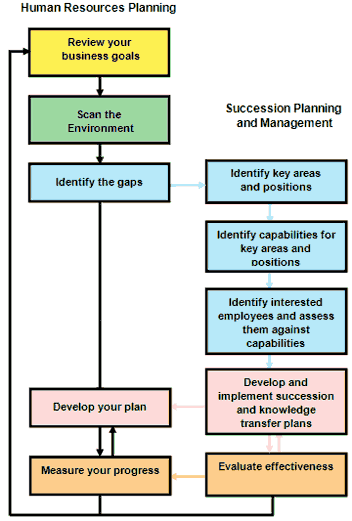2.1 Human Resources Planning and Processes
HR Planning is a strategic process that helps companies plan for future human resources needed to support the growth or downsizing of production demands. It allows companies to predict the future, analyze the company’s needs, decide the market availability of candidates for specific jobs, and decide when and how to adapt and use human resources (people). Companies must respond quickly to market trends and changes in today’s rapidly changing workplace. The HR Plan helps them to respond efficiently. It is often coined that companies need to have “the right people in the right place at the right time.” To complement this saying, it is also essential for companies to have a plan, practices and policies.
Workforce Plan Development Competencies
- Maintain an understanding of the organization’s vision, mission, values, and goals.
- Create a future-focused workforce plan.
- Measure gaps in current talent needs.
- Assess future talent needs.
Source: HRPA Professional Competency Framework (2014), pg. 14. © HRPA, all rights reserved.
When developing the HR Plan, it is crucial to align with the strategic plan (refer to Chapter 1) and bring the two together with a focus on the company’s longer-term success. HR departments begin an HR Plan by predicting or anticipating the number of employees they will need with the expansion and what skills the new employees will need to possess.

There are five main activities involved in HR Planning to ensure the company’s strategic goals are met. The five steps are as follows:
- Review your business goals
- Scan the environment
- Identify the gaps
- Develop your plan
- Measure your progress
Step 1: the organization should review its business goals and develop governance structures, systems, and processes to support human resources and business planning.
Step 2: the business should scan the environment for internal and external factors that may influence the organization’s capacity to achieve its goals.
Step 3: involves identifying gaps by analyzing the current situation and comparing it with the desired state.
Step 4: the organization must develop a plan that prioritizes human resources to achieve business goals and implement strategies to close the gaps identified in step three.
Step 5: involves measuring progress and periodically reviewing and updating the human resources plan. The article also provides questions to consider for each step.
Workforce Plan Execution Competencies
- Measure the impact of attraction initiatives.
- Measure employee retention.
- Measure gaps in current talent needs.
- Assess future talent needs.
- Identify the characteristics of desirable potential employees.
- Execute a workforce plan in accordance with sound project management principles.
- Determine the optimal methods for sourcing desirable potential employees.
- Identify potential employees using an appropriate mix of interviews, assessments, and reference checks.
- Select potential employees based on available evidence of fit with organizational strategic objectives.
- Orient new employees to the culture of the organization and the organization’s strategic objectives.
- Train new employees in a manner consistent with their competencies and the needs of the position.
- Create development plans for employees that are designed to fill gaps between current and future organizational skills needs.
- Implement measures to retain top talent.
Source: HRPA Professional Competency Framework (2014), pg. 14. © HRPA, all rights reserved.
To learn more about the steps and the questions HR managers should consider, see The Human Resources Planning Guide for Executives by the Treasury Board of Canada.
“2.1 Human Resources Planning and Strategy” and “2.2 The HR Planning Process” from Human Resources Management – 3rd Edition by Debra Patterson are licensed under a Creative Commons Attribution-NonCommercial-ShareAlike 4.0 International License, except where otherwise noted.
“Human Resources Planning Guide for Executives” by the Treasury Board of Canada is used in accordance with the Government of Canada Terms and Conditions.

